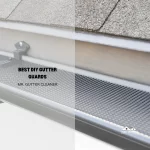Mold poses a significant concern in homes, affecting air quality and potentially leading to health issues. Its presence often indicates moisture problems, which, if unaddressed, can cause structural damage.
Blocked gutters are a common culprit behind such moisture issues, emphasizing the importance of regular gutter cleaning in home maintenance.
Gutters clogged with leaves and debris prevent proper water flow away from the house, leading to water accumulation and, consequently, damp conditions favorable for mold growth.
This scenario underscores the interconnectedness of gutter maintenance with overall home care, highlighting the critical role of preventing mold by ensuring that water can freely flow away from the property.
Addressing gutter blockages promptly not only mitigates the risk of mold but also contributes to preserving the home’s structural integrity and indoor air quality, safeguarding the occupants’ health.
What Is Mold?
Mold constitutes a form of fungi that thrives in moist environments, both indoors and outdoors. It plays a crucial role in nature by breaking down dead organic matter; however, when it grows uncontrollably inside homes, it can pose significant health and structural risks. Mold reproduces through tiny, airborne spores that can easily infiltrate indoor spaces, settling on surfaces where moisture is present.
How Does Mold Grow?
Mold growth initiates when mold spores land on wet or damp surfaces. It requires moisture, a nutrient source, such as wood or paper, and suitable temperatures to grow. This growth can start within 24 to 48 hours under optimal conditions, emphasizing the importance of addressing moisture issues promptly to prevent mold proliferation.
Different Types of Mold Found in Homes
Several mold species commonly inhabit residential areas, including but not limited to Aspergillus, Penicillium, and Stachybotrys chartarum, often referred to as black mold. Each type varies in appearance and potential health effects, making it vital to identify and remove them efficiently to maintain indoor air quality and protect residents’ health.
Health Impacts of Mold Exposure
Mold exposure can significantly affect health, ranging from mild allergic reactions to severe respiratory conditions. Recognizing the potential health impacts is crucial for homeowners to take timely action against mold presence in their homes.
Short-Term Effects on Health
Short-term exposure to mold may trigger allergies, causing symptoms such as sneezing, itching, runny nose, and red eyes. Individuals with asthma might experience aggravated asthma symptoms, including difficulty breathing and increased asthma attacks.
Long-Term Health Risks
Prolonged exposure to mold can lead to more serious health issues, including chronic respiratory conditions, immune system suppression, and, in severe cases, lung infections. It is especially concerning for individuals with pre-existing health conditions, underscoring the need for prompt mold remediation.
Who Is Most at Risk?
Individuals with compromised immune systems, allergies, asthma, and other respiratory conditions are at higher risk of experiencing adverse health effects from mold exposure. Children, elderly people, and pregnant women also fall into the higher risk category, necessitating vigilant mold prevention and control measures in homes.
Signs of Mold in Your Home
Identifying mold in your home early is crucial for maintaining a healthy living environment and preventing structural damage. Awareness of the common signs of mold can help homeowners address the issue promptly.
Visible Signs of Mold
Visible signs of mold include discolored walls, ceilings, or floors, often appearing as patches that can be black, green, or white. Mold might also manifest as a fuzzy or slimy texture on surfaces, indicating active growth.
Detecting Hidden Mold
Mold can thrive in hidden areas, such as behind wallpaper, underneath carpets, or within HVAC systems. A musty odor is a key indicator of hidden mold. If a persistent damp, earthy smell is present, it suggests mold growth in areas not immediately visible.
Symptoms of Mold Exposure in Residents
Residents exposed to mold may experience health symptoms, including respiratory issues, allergic reactions, headaches, or fatigue. Persistent health problems without a clear cause may signal mold exposure, emphasizing the need for a thorough home inspection.
Causes of Mold in Homes
Understanding the causes of mold in homes is pivotal for effective prevention and maintaining a healthy living environment. Moisture control is the key to mold prevention, highlighting the importance of regular home maintenance.
How Blocked Gutters Can Lead to Mold
Blocked gutters are a primary cause of mold in homes. They prevent proper water drainage, causing water to overflow and seep into the foundation and walls, creating damp conditions ideal for mold growth. Regular gutter cleaning ensures water is directed away from the home, reducing the risk of mold development.
Other Common Causes of Damp and Mold
Besides blocked gutters, several other conditions can contribute to dampness and mold growth in homes. These include leaking pipes, poor ventilation, and condensation. Identifying and addressing these issues promptly can significantly reduce the likelihood of mold proliferation.
Preventing Mold Growth
Preventing mold growth is essential for maintaining a healthy home environment and protecting the structural integrity of your property. Effective prevention focuses on controlling moisture and ensuring proper home maintenance.
Importance of Gutter Maintenance
Gutter maintenance plays a pivotal role in preventing mold growth. Clean gutters ensure water is efficiently channeled away from your home, preventing water accumulation around the foundation, which is a common cause of damp conditions conducive to mold. Regular gutter cleaning and inspection prevent blockages that can lead to water seepage and mold issues.
Ventilation and Humidity Control
Proper ventilation and humidity control within the home are crucial for mold prevention. Use of exhaust fans in high-moisture areas like bathrooms and kitchens, along with dehumidifiers in humid climates, can significantly reduce indoor moisture levels. Ensuring adequate air circulation prevents the damp conditions mold requires to thrive.
Regular Home Maintenance Checks
Conducting regular home maintenance checks can identify and rectify potential mold growth sources early. This includes checking for leaks in roofs, pipes, and windows, and ensuring the home’s exterior is properly sealed and waterproofed. Addressing these issues promptly can deter mold growth by eliminating moisture sources.
Safe Mold Removal Techniques
Safely removing mold is critical to ensuring a healthy living environment. Homeowners can tackle mold removal effectively with the right techniques and precautions, mitigating health risks and preventing future growth.
DIY Mold Removal Solutions
For small areas of mold, homeowners can use a mixture of water and detergent or a solution of water and vinegar to clean the affected surfaces. It’s important to wear gloves and a mask to prevent inhaling spores. After cleaning, the area should be thoroughly dried to prevent mold from returning.
When to Call a Professional
If mold covers a large area or if you’re dealing with toxic black mold, it’s essential to call in professional mold removal services. Professionals have the expertise and equipment to safely remove mold, especially in cases where it has penetrated deep into surfaces or building materials.
Preventing Future Mold Growth
Preventing future mold growth involves addressing the root causes of moisture accumulation. This includes ensuring gutters are clean and functioning correctly, fixing leaks promptly, and maintaining adequate ventilation throughout the home. Regular inspections can help catch and resolve potential mold issues early.
Legal Aspects and Insurance
Understanding the legal aspects and insurance coverage related to mold in homes is essential for homeowners. This knowledge not only aids in navigating responsibilities but also in seeking compensation or assistance if mold becomes a significant issue.
Homeowner’s Responsibilities
Homeowners are primarily responsible for maintaining their property to prevent mold growth. This includes regular inspections, proper home maintenance, and addressing moisture issues promptly. In some jurisdictions, failure to control mold can lead to legal implications, especially if it affects neighboring properties or tenants’ health in rental situations.
Understanding Your Insurance Coverage
Most homeowner insurance policies cover mold damage only if it results from a “covered peril,” such as water damage from a sudden and accidental leak. It’s crucial to review your policy to understand what is and isn’t covered regarding mold remediation. Some insurers offer mold coverage as an add-on at an additional cost. Knowing your coverage details can help in making informed decisions about mold prevention and remediation efforts.
FAQ About Mold and Home Maintenance
This section addresses frequently asked questions about mold and its relation to home maintenance, providing homeowners with concise, actionable insights.
Can Mold Grow Anywhere Else Besides Walls?
Yes, mold can grow on any surface where moisture and organic material are present. Common areas include ceilings, carpets, in HVAC systems, and behind appliances where leaks or condensation can occur. Regular inspections and maintenance are key to preventing mold in these areas.
How Often Should Gutters Be Cleaned?
Gutters should be cleaned at least twice a year, in the spring and fall, to prevent blockages that can lead to water damage and mold growth. Homes in areas with heavy tree coverage may require more frequent cleaning to prevent gutter blockages.
Signs That Professional Mold Removal Is Needed
Professional mold removal is recommended when mold covers a large area (greater than 10 square feet), is in HVAC systems, or if mold comes back after DIY cleaning. Other signs include health symptoms among residents when in the house, indicating a potential hidden mold problem.


